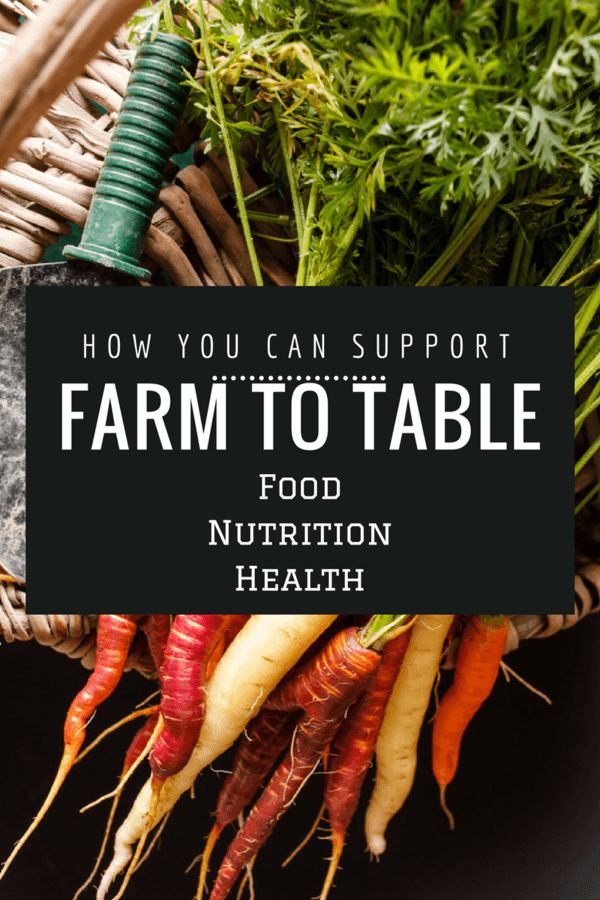
Ever heard of the phrase “Farm to Table?”
It’s a phrase that can mean different things to different people. The reality of the world means that the food on the table came directly from a specific farm -without going through a store, market or distributor at some point along the way.
Using the words “Farm to Table” implies that there is a one on one relationship between a farm and a restaurant – or, people in some ways, too. Farmers can benefit by being able to score more of a profit their goods can earn and many people enjoy farm to table because they know where their food is coming from and how it is cooked.
In looser terms, Farm to Table can also refer to farmers markets, CSA’s and Raw Milk farmers where people can buy food directly from the farm or grower, and bring home directly to the table at their home.
The Beginning of the Farm to Table Movement
Back in the 1960’s, the movement began and rose out of concerns for food traceability – knowing where food came from, the origin of the ingredients within the food and the treatment of the animals involved, as well as the freshness of the ingredients.
Many people who believe in the farm to table movement see problems with our current food system:
- Scarcity of fresh, local ingredients
- Lack of flavor in items shipped from far
- Poor nutritional quality of food that is shipped from afar
- The overuse use of genetically modified ingredients into our food supply
- The dwindling numbers of small family farms in a system that has encroached upon farms in lieu of profits and mass production
And the list could go on and on – for many of these farmers, it gives them an opportunity to embrace free range, fair trade, organic and sustainable farming, with the goal to avoid genetically modified food, the use of pesticides and herbicides, and the use of antibiotics and hormones to make animals grow faster and produce more
Is Local Really Important?
Although many people may not realize the importance of Farm to Table, a recent survey by the National Restaurant Association shows that 57% of consumers see availability of local food as a determining factor in their decision to dine out at a local establishment, while 68% of them would prefer to visit a restaurant offering locally produced items.
While the concept of farm to table is great, some restaurants are in many cases willing to cut corners to meet the requirements of these consumers. Unfortunately regulators haven’t defined “local” and “sustainable” – which creates questions for those of us who are looking to support local farms, local food or who have like minded concerns about the nation’s food system.
Many restaurants may compromise local, sustainable food to meet the pressure of the consumer’s expectations.
Thankfully, you can support your local farm to table effort at home by making your own food – which saves you money long term and gives you peace of mind that the food you are eating truly is sourced locally.
How you can Support your Local Farm to Table Effort
While the concept of farm to table isn’t new, many people have concerns about where their food comes from. … how it’s raised or grown, and how far it travels to get to it’s end destination.
Being aware of where your food comes from can lead to a greater appreciation for your food.
Today, we have highways and freeways – which make it incredibly easy for truckers to move mass quantities of food around from state to state. We have planes – that bring our produce from all over the globe – despite the growing season. We have never been so far removed from the food we eat ~ whether produce, milk or meat. The idea of stocking up a pantry in most cases means traveling to the grocery store.
You might even see the local grocery store advertise “Farm to Table” (which is undoubtedly a STRETCH – but it’s the truth!) – which may hold a tiny bit of truth, but farm to table doesn’t mean farm to “grocery” store to table – so even they are trying to reach out to those of us with concerns.
Food now comes in boxes, and plastic wrap. Rarely ever does food come raw — and if and when it does, we are warned that it’s unsafe, risky and in some cases, bad for our health. But yet food that is mass produced on a factory line and thrown in a box, where it’s trucked 1,500 miles is not in any case risky. We are constantly marketed with cheap, factory farmed meat on the front page ads of our grocers – where affordability reigns over quality meat. Budgets are tight… therefore we just buy what’s affordable, and forget what’s not – right?
Being aware of where your food comes from gives you a deeper appreciation for your food. It takes considerable work to make your meals a possibility.
So how can you support your local Farm to Table effort?
Take part in a community CSA (Community Supported Agriculture)
Investing in a family or a single bag each week is a commitment – not only a commitment to cost ($17 – $25), but a commitment to you and your family.
Every week is different.
The items you receive each week are those that are in season – locally grown, without pesticides or herbicides.
Knowing that your CSA bag dictates your meals, you make an effort to find a use for ALL of those items – in meals and dishes. You waste less ~ you aren’t overbuying sale items from the store. You feel compelled to put every item to use, even if it means giving your children things they would not have normally tried.
One of the most common CSA’s in the Valley is Taste of Paradise – You will receive a weekly bag of produce that will contain 8 pre-selected varieties of locally grown, organic fruits and vegetables. The produce will vary each week and throughout the seasons, and will come in multiple pounds and quantities.
Shop your Farmers Market
While big corporations advertise their packaged, processed food at the grocery store through huge government subsidies, you might capture produce that isn’t really the most fresh – that has traveled for miles, been heavily sprayed with generous amounts of pesticide, and in most cases, isn’t helping a local farmer that works tirelessly to keep his customers well stocked with produce that is usually pesticide free, and well cared for.
Thankfully, we have many Farmers Markets in Arizona. We also have a Farmers Market Nutrition Program for those on a limited income, too.
They aren’t just on weekends, you can also visit on select weeknights too – the Superstition Farm Farmers Market every Thursday provides the ability for you to pick up your CSA bag from Taste of Paradise AND shop the Farmers Market for additional produce.
Although many of the farmers markets in Arizona close for the summer, several run through the entire year – get the list HERE. Are you on a limited budget? If so, Arizona offers the Arizona Farmers Market Nutrition Program for select people, too.
Buy your {Raw} Milk directly from the Farm
Pasteurized Milk today comes from cows crammed in cages loaded with synthetic hormones and antibiotics.. (Confined Animal Feeding Operations – CAFO’s).
That pasteurization, which is “natural” to the FDA, destroys the chemical makeup and enzymes in milk, which are essential to providing health benefits: the result essentially is that everything is now killed and dead. Calcium is rendered to be less useful, because vitamin D and vitamin K, along with phosphorus, which are essential for absorption) are nonexistent.
Raw milk, on the other hand, is not pasteurized .. and is an excellent source of calcium, and other nutrients such as vitamins, enzymes, and bacteria, which are not destroyed because the milk is not heated. Raw Milk has many benefits – which you can read about HERE.
Interested in Raw Milk in your area? Go HERE to find a farm near to you.
Buy your Meat from a Local Farmer
Buying your Meat directly from a farmer is not only more satisfying, it gives you the chance to meet the person who raised the animal – it gives you the chance to ask questions on the meat you will be ingesting. Not only that, it gives you control of your food at a price that might just be more favorable than the supermarket.




Leave a Reply
You must be logged in to post a comment.